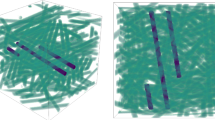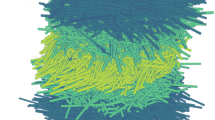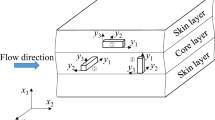Abstract
We present an algorithm for generating volume elements of short fiber reinforced plastic microstructures for prescribed fourth order fiber orientation tensor, fiber aspect ratio and solid volume fraction. The algorithm inserts fibers randomly into an existing microstructure, and removes the resulting overlap systematically based on a gradient descent method. In contrast to existing methods, large fiber aspect ratios (up to 150) and large volume fractions (60 vol% for isotropic orientation and aspect ratio of 33) can be reached. We study the effective linear elastic properties of the resulting microstructures, depending on fiber orientation, volume fraction as well as aspect ratio, and examine the size of a corresponding representative volume element.







Similar content being viewed by others
References
Abdulle A, Bai Y (2014) Reduced order modelling numerical homogenization. Philos Trans R Soc 372:1–23
Advani SG, Tucker CL (1987) The use of tensors to describe and predict fiber orientation in short fiber composites. J Rheol 31(8):751–784
Altendorf H, Jeulin D (2011) Random walk based stochastic modeling of 3D fiber systems. Phys Rev E 83(4):1–10
Bakhvalov N, Panasenko G (1989) Homogenisation: averaging processes in periodic media: mathematical problems in the mechanics of composite materials. Mathematics and its applications. Soviet series. Kluwer Academic Publishers, Dordrecht
Birgin E, Martínez J, Ronconi DP (2005) Optimizing the packing of cylinders into a rectangular container: a nonlinear approach. Appl Math Program Models 160:19–33
Bohm H, Eckschlager A, Han W (2002) Multi-inclusion unit cell models for metal matrix composites with randomly oriented discontinuous reinforcements. Comput Mater Sci 25:42–53
Browaeys JT, Chevrot S (2004) Decomposition of the elastic tensor and geophysical applications. Geophys J Int 159:667–678
Cintra JS, Tucker CL (1995) Orthotropic closure approximations for flow-induced fiber orientation. J Rheol 39(6):1095–1122
Coelho D, Thovert JF, Adler PM (1997) Geometrical and transport properties of random packings of spheres and aspherical particles. Phys Rev E 55(2):1959–1978
Dray D, Gilormini P, Régnier G (2007) Comparison of several closure approximations for evaluating the thermoelastic properties of an injection molded short-fiber composite. Compos Sci Technol 67(7–8):1601–1610
Duschlbauer D, Bohm H, Pettermann HE (2006) Computational simulation of composites reinforced by planar random fibers: homogenization and localization by unit cell and mean field approaches. J Compos Mater 40:2217–2234
Düster A, Sehlhorst HG, Rank E (2012) Numerical homogenization of heterogeneous and cellular materials utilizing the finite cell method. Comput Mech 50(4):413–431
Feder J (1980) Random sequential adsorption. J Theor Biol 87(2):237–254
Fliegener S, Luke M, Gumbsch P (2014) 3D microstructure modeling of long fiber reinforced thermoplastics. Compos Sci Technol 104:136–145
Folgar F, Tucker C (1984) Orientation behavior of fibers in concentrated suspensions. J Reinf Plast Compos 3:98–119
García AG (2015) Random packings via mechanical contraction. Master’s thesis, Universiteit Utrecht, Utrecht
GeoDict. Math2Market GmbH http://www.geodict.de, Kaiserslautern, Germany. Accessed: 2016-08-01
Ghosh S, Lee K, Moorthy S (1995) Multiple scale analysis of heterogeneous elastic structures using homogenization theory and voronoi cell finite element method. Int J Solids Struct 32(1):27–62
Ghossein E, Lévesque M (2013) Random generation of periodic hard ellipsoids based on molcular dynamics: A computationally-efficient algorithm. J Comput Phys 253:471–490
Guedes JM, Kikuchi N (1990) Preprocessing and postprocessing for materials based on the homogenization method with adaptive finite element methods. Comput Methods Appl Mech Eng 83:143–198
Gusev A (1997) Representative volume element size for elastic composites: numerical study. J Mech Phys Solids 45:1449–1459
Gusev A, Heggli M, Lusti H, Hine PJ (2002) Orientation averaging for stiffness and thermal expansion of short fiber composites. Adv Eng Mater 4:931–933
Gusev A, Hine PJ, Ward IM (2000) Fiber packing and elastic properties of a transversely random unidirectional glass/epox composite. Compos Sci Technol 60:535–541
Hill R (1963) Elastic properties of reinforced solids: some theoretical principles. J Mech Phys Solids 11:357–372
Kanatani KI (1984) Distribution of directional data and fabric tensors. Int J Eng Sci 22:149–164
Kari S, Berger H, Gabbert U (2007) Numerical evaluation of effective material properties of randomly distributed short cylindrical fibre composites. Comput Mater Sci 39:198–204
Leuschner M, Fritzen F, van Dommelen J, Hoefnagels J (2015) Potential-based constitutive models for cohesive interfaces: Theory, implementation and examples. Compos Part B Eng 68:38–50
Mattson W, Rice BM (1999) Near-neighbor calculations using a modified cell-linked list method. Comput Phys Commun 119:135–148
Michel JC, Suquet P (2016) A model-reduction approach in micromechanics of materials preserving the variational structure of constitutive relations. J Mech Phys Solids 90:254–285
Müller V, Böhlke T (2016) Prediction of effective elastic properties of fiber reinforced composites. Compos Sci Technol 130:36–45
Müller V, Kabel M, Andrä H, Böhlke T (2015) Homogenization of linear elastic properties of short-fiber reinforced composites—a comparison of mean field and voxel-based methods. Int J Solids Struct 67–68:56–70
Montgomery-Smith S, He W, Jack DA, Smith DE (2011) Exact tensor closures for the three-dimensional Jeffery’s equation. J Fluid Mech 680:321–335
Montgomery-Smith S, Jack D, Smith DE (2011) The Fast Exact Closure for Jefferys equation with diffusion. J Nonnewton Fluid Mech 166(7–8):343–353
Mosby M, Matouš K (2016) Computational homogenization at extreme scales. Extreme Mech Lett 6:68–74
Moulinec H, Suquet P (1998) A numerical method for computing the overall response of nonlinear composites with complex microstructure. Comput Methods Appl Mech Eng 157(1–2):69–94
Nardin M, Papiere E, Schultz J (1985) Contribution l’etude des empilements au hasard de fibres et/ou de partiules spheriques. Powder Technol 44:131–140
Pan Y, Iorga L, Pelegri AA (2006) Numerical generation of a random chopped fiber composite RVE and its elastic properties. Compos Sci Technol 68:56–66
Parsheh M, Brown ML, Aidun CK (2006) Investigation of closure approximations for fiber orientation distribution in contracting turbulent flow. J Nonnewton Fluid Mech 136(1):38–49
Philipse AP (1996) The random contact equation and its implications for (colloidal) rods in packings, suspensions and anisotropic powders. Langmuir 12:1127–1133
Pournin I, Weber M, Tsukahara M, Ferrez JA, Ramaioli M, Liebling T (2005) Three-dimensional distinct element simulation of spherocylinder crystallization. Granular Matter 7:119–126
Salnikov V, Choï D, Karamian-Surville P (2015) On efficient and reliable stochastic generation of RVEs for analysis of composites within the framework of homogenization. Comput Mech 55:127–144
Schneider M, Merkert D, Kabel M (2016) FFT-based homogenization for microstructures discretized by linear hexahedral elements. Int J Numer Methods Eng 1–29 (2016)
Schneider M, Ospald F, Kabel M (2016) Computational homogenization of elasticity on a staggered grid. Int J Numer Methods Eng 105(9):693–720
Schwen LO, Wolfram U (2014) Validation of composite finite elements efficiently simulating elasticity of trabecular bones. Comput Methods Biomech Biomed Eng 17:652–660
Sun CT, Vaidya RS (1996) Prediction of composite properties from a representative volume element. Compos Sci Technol 56:171–179
Tian W, Qi L, Zhou J, Liang J, Ma Y (2015) Representative volume element for composites reinforced by spatially randomly distributed discontinuous fibers and its applications. Compos Struct 131:366–373
Tyler DE (1987) Statistical Analysis for the Angular Central Gaussian Distribution on the Sphere. Biometrika 74(3):579–589
Vega C, Lago S (1994) A fast algorithm to evaluate the shortest distance between rods. Comput Chem 18:55–59
Verlet L (1967) Computer ’experiments’ on classical fluids. I. Thermodynamical properties of Lennard-Jonear molecules. Phys Rev 159:98–103
Widom B (1966) Random sequential addition of hard spheres to a volume. J Chem Phys 44(10):3888–3894
Williams S, Philipse A (2003) Random packings of spheres and spherocylinders simulated by mechanical contraction. Phys Rev E 67:1–9
Acknowledgments
The author thanks the anonymous referees for suggestions leading to a huge improvement of the manuscript, Jonathan Köbler for help with the OpenMP parallelization of the code and Felix Ospald for a careful reading of the final version.
Author information
Authors and Affiliations
Corresponding author
Appendix A
Appendix A
The Appendix contains details how to compute the differentials in Eqs. (5) and (8).
1.1 Differentiating f in (5)
We use the notation of Sect. 2.2. For each pair \(i\ne j\) the vector \(k_{ij}\) is determined from the minimization problem
with the constraints \(s,t\in [-1,1]\) and
Introducing the dual variables \(\alpha ,\beta ,\gamma \) and \(\delta \) the corresponding KKT system reads
We examine how \(\tfrac{1}{2} \Vert k_{ij}\Vert ^2\) changes with \(x_i\), i.e.
where we have used the KKT system (12) in the last line. (Notice that we use \(\langle u,v\rangle \) and \(u\cdot v\) interchangeably to denote the Euclidean scalar product.)
First we analyze the term \(\frac{\partial s}{\partial x_i}[\xi ] \alpha \). We will show that it is identically zero. Suppose that \(\alpha >0\). Otherwise there would be nothing to show. Consider the complementary slackness \((1+s)\alpha =0\). As \(\alpha >0\), we have \(s=-1\). Differentiating the complementary slackness yields
where we have used that \(s=-1\). Thus, the term \(\frac{\partial s}{\partial x_i}[\xi ] \alpha \) vanishes. Argumenting analogously we see that the other three terms \(\frac{\partial s}{\partial x_i}[\xi ]\beta \), \(\frac{\partial t}{\partial x_i}[\xi ]\gamma \) and \(\frac{\partial t}{\partial x_i}[\xi ]\delta \) in (13) vanish. Thus, we conclude
Using this previous result, the differentiating the objective function
with \(\delta _{ij}=\max \{0,D-\Vert k_{ij}\Vert \}\) in (5) proceeds as follows:
leading to the first line in (6).
Differentiating w.r.t. \(p_i\) proceeds similarly. Notice that in contrast to (13) the product sL / 2 appears
However, this is the only difference. Denoting the s-parameter for the i-j-collision by \(s_{ij}\) similar arguments as for the \(x_i\)-derivative permit us to conclude
representing the second line in (6).
1.2 Computing the gradient of the orientation term
We wish to differentiate the function
with \(\mathbb {A}_N=\sum _{i=1}^N p_i\otimes p_i\otimes p_i\otimes p_i\) at \(p_i\) in direction \(\eta \) orthogonal to \(p_i\). Then,
Taking into account the full symmetry of \(\mathbb {A}\) and \(\mathbb {A}_N\) w.r.t. the permutation of indices the latter expression can be simplified to
proving (9).
Rights and permissions
About this article
Cite this article
Schneider, M. The sequential addition and migration method to generate representative volume elements for the homogenization of short fiber reinforced plastics. Comput Mech 59, 247–263 (2017). https://doi.org/10.1007/s00466-016-1350-7
Received:
Accepted:
Published:
Issue Date:
DOI: https://doi.org/10.1007/s00466-016-1350-7




